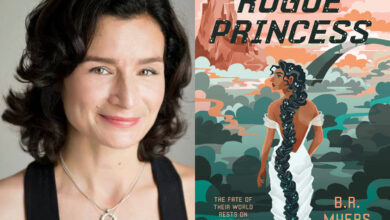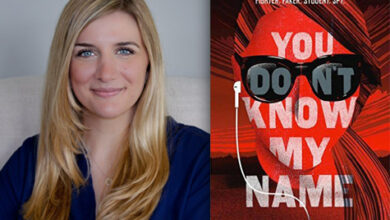David Wroblewski’s “Familiaris” explores previous novel’s character

David Wroblewski is the author, most recently, of the novel “Familiaris,” his followup to the international bestseller “The Story Of Edgar Sawtelle.” He received an MFA in Creative Writing from the Warren Wilson MFA Program for Writers, and a Bachelor’s degree in computer science from the University of Wisconsin. He lives on Colorado’s Front Range with the writer Kimberly McClintock and their dog Luci.
SunLit: Tell us this book’s backstory – what’s it about and what inspired you to write it?
David Wroblewski: “Familiaris” exists because John Sawtelle kept forcing his way into “The Story of Edgar Sawtelle” as I was writing it, even though according to the story’s timeline, he’d passed away over a decade before the main action of Edgar’s story takes place. But certain family legends kept emerging (John is introduced as being “born with an extra share of whimsy,”) as well as a trove of letters. But these were only hints. By the time I’d finished writing “The Story of Edgar Sawtelle” I wanted to know John’s full story. The result was “Familiaris.”
UNDERWRITTEN BY
Each week, The Colorado Sun and Colorado Humanities & Center For The Book feature an excerpt from a Colorado book and an interview with the author. Explore the SunLit archives at coloradosun.com/sunlit.
“Familiaris” and “The Story of Edgar Sawtelle” are mainly set on the same 90-acre farm in remote northern Wisconsin. The main character is John Sawtelle, Edgar’s grandfather, who sets out in 1919 (along with his newlywed wife Mary and his two best friends) to rehabilitate a run-down farm, and in the process (John hopes) discover a larger purpose for their lives. For John and Mary, as readers of “The Story of Edgar Sawtelle” know, that will be raising and training dogs, at first drawn from the most exceptional dogs within an hour’s drive of the farm, but which by the time of “The Story of Edgar Sawtelle” have evolved into a unique breed known only as “Sawtelle dogs.”
SunLit: Place the excerpt you selected in context. How does it fit into the book as a whole and why did you select it?
Wroblewski: The excerpt I’ve chosen appears fairly early, in the fourth chapter. It’s the only flashback to John’s childhood in the entire novel. I like it in part because it shows John at the mercy of his own imagination even in childhood, and also because I had so much fun writing this scene, which draws on the antics of my own grade school classmates in ways only they might recognize.
SunLit: What influences and/or experiences informed the project before you sat down to write?
“Familaris”
Where to find it:

SunLit present new excerpts from some of the best Colorado authors that not only spin engaging narratives but also illuminate who we are as a community. Read more.
Wroblewski: The most profound influence was, I suppose, my childhood: the Sawtelle farm depicted in these novels is a reimagined and slightly exaggerated version the farm where I grew up, relocated north by a hundred miles or so and turned into a kind of stage set where Edgar’s story, as well as John and Mary’s, could play out.
So place is one deep influence: the land, the seasons, the connection to nature. But it’s also true that when I was a child my parents raised dogs, so I was also drawing on childhood memories of being surrounded by dogs — pups, usually, since my main kennel chore was socializing litters of pups. Which is a fancy way of saying that my job was to play with them.
SunLit: What did the process of writing this book add to your knowledge and understanding of your craft and/or the subject matter?
Wroblewski: When I began writing “Familiaris” I imagined a fairly small novel, maybe half the length of “The Story of Edgar Sawtelle.” But as the true scope of John’s story became clear, I was forced to admit, grudgingly, that I was dealing with something bigger.
Eventually (and by “eventually” I mean, after several years of continually losing the “this is a short novel” battle) I capitulated and let the story play out at the length it wanted to be. For me, the lesson was simple: a writer’s preconception of what they’re making becomes almost irrelevant once the work is underway; it’s far more important to pay attention to the strengths, weaknesses, and interesting peculiarities of the thing as it develops, and respond to that.
The philosopher Donald Schön called this a “reflective conversation with the materials of the situation.” I like that phrase. It neatly captures the improvisational nature of writing as I’ve experienced it.
SunLit: What were the biggest challenges you faced in writing this book?
Wroblewski: See above: length. For most readers, the worry about long novels is, what if I get partway in and it turns out to be boring? What if it goes so slowly that I’ll see what’s going to happen long before it takes place? What if all those pages mean the story will descend into self-indulgent perseveration? I spent virtually every day of my work on “Familiaris” making sure none of those things would be the case.
SunLit: What do you want readers to take from this book?
Wroblewski: The main thing I’d want a reader to take from any novel is just the moment-by-moment experience of reading that novel. Because a novel is more than just a story; it’s a carefully crafted ride, one that gets woven into your life over the course of days or even weeks. That interwoven-ness is what makes the novel such a potent form. It’s why you can reread a novel and enjoy it just as much, or even more, than the first time through: the words remain the same, but you’re a different person.
That said, I suspect readers of “Familiaris” may wind up pondering, among other things, their relationships with the dogs they’ve known, the surprising ways that love, both romantic and fraternal, can manifest, and how they’ve made (or might still make) something lasting and beautiful in the world, which is John’s driving desire.
SunLit: Before you were a published novelist you had a long career in computer science research. What if anything from that work has influenced your writing or writing process?
Wroblewski: In terms of surface subject matter, there’s very little crossover. Both “The Story of Edgar Sawtelle” and “Familiaris” take place in rural Wisconsin between 1919 and 1972, and the stories don’t involve much technology except cars and telephones. But at a deeper level, both these stories are about people seeking to either make or preserve something rare and beautiful, and in my research life I was lucky enough to work with many extraordinarily talented and passionate people trying to accomplish something analogous in the realm of computer science.
From them I learned just how hard a person must work, even if they’re brilliant, to create something truly new and significant. Similarly, both Edgar and John, in their ways, devote their lives to a vision of rightness and beauty.
In terms of writing process, programming taught me how to build complex, functional things using language as the raw material. It showed me how slippery language can be (even if only a programming language), how slowly the best solutions reveal themselves, and the perseverance required to make the best possible version of a thing.
Programming turned out to be my “wax on, wax off” practice: by the time I decided to try writing a novel, certain skills and attitudes had long become reflexes that I could depend on. Without them, I suspect I never would have finished “The Story of Edgar Sawtelle,” let alone “Familiaris.”
A few more quick items
Currently on your nightstand for recreational reading: “Middlemarch” by George Eliot, “Slow Horses” by Mick Herron, “Twist” by Colum McCann
First book you remember really making an impression on you as a kid: Kipling’s “The Jungle Book”
Best writing advice you’ve ever received: Robert Boswell’s notion of “transitional drafts,” which involves writing many, many drafts, each with a radically limited scope of concern, and prioritized by approachability rather than importance.
Favorite fictional literary character: I have to pick just one? OK: Hazel-Rah!
Literary guilty pleasure (title or genre): No guilt over any reading, ever. But you might be surprised at how much I enjoy well-written books on computer programming and programming languages.
Digital, print or audio – favorite medium to consume literature: I use them all, and like them all. When I really love a book, I wind up with all three.
One book you’ve read multiple times: “A Farewell to Arms,” by Ernest Hemingway.
Other than writing utensils, one thing you must have within reach when you write: Sound blocking headphones and a big glass of Coke Zero.
Best antidote for writer’s block: Getting stuck, for me, is usually a sign that I haven’t broken the problem down far enough. The solution is Boswell’s transitional drafts technique, as described above.
Most valuable beta reader: My life and creative partner, Kimberly McClintock
Source link



